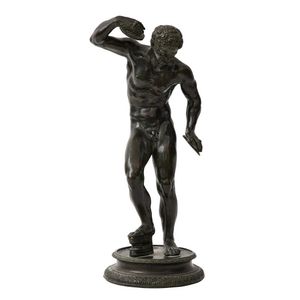A Grand Tour bronze of the dancing faun, 19th century, after…
A Grand Tour bronze of the dancing faun, 19th century, after the Hellenistic original housed in the Uffizi gallery in Florence, the naked faun holding cymbals on a circular leaf cast base. Height 27 cm. Provenance: The Estate of the Hon. Dr John Kennedy McLaughlin Am, Sydney
You must be a subscriber, and be logged in to view price and dealer details.
Subscribe Now to view actual auction price for this item
When you subscribe, you have the option of setting the currency in which to display prices to $Au, $US, $NZ or Stg.
This item has been sold, and the description, image and price are for reference purposes only.
- Hellenistic - The Hellenistic period is a period in ancient Greek history
that began after the death of Alexander the Great in 323 BCE and lasted until
the Roman conquest of Greece in 146 BCE. It is named after the Greek word
"Hellenistic," which means "to imitate Greeks."
During the Hellenistic period, the Greek world expanded
beyond the boundaries of Greece and encompassed the territories conquered by
Alexander the Great, including Egypt, Persia, and parts of India. The period
was marked by a fusion of Greek culture with the cultures of these conquered
territories, resulting in a diverse and cosmopolitan society.
The art and architecture of the Hellenistic period were
marked by a new sense of realism and individuality. Artists and architects
experimented with new techniques and styles, and the incorporation of new
materials such as bronze and glass. A number of the best-known works of Greek sculpture belong to this period, including Laocoon and his Sons, Venus de Milo, and the Winged Victory of Samothrace. - Bronze - An alloy of copper and tin, traditionally in the proportions of about 9 parts of copper to 1 part of tin.
The discovery of bronze in Western Asia in the 4th century enabled people to create metal objects which were superior to those previoulsy possible because of its strength and hardness, and it has been used throughout the world for weapons, coins, tools, statuary and other decorative items.
It is very fluid in a molten state, and its hardness, strength when set, and non-corrosive properties makes it most suitable for casting sculpture.
This item has been included into following indexes:
